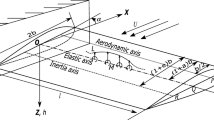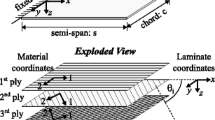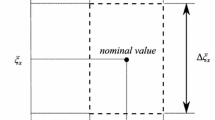Abstract
The article presents physics based time invariant generalized flutter reliability approach for a wing in detail. For carrying flutter reliability analysis, a generalized first order reliability method (FORM) and a generalized second order reliability method (SORM) algorithms are developed. The FORM algorithm requires first derivative and the SORM algorithm requires both the first and second derivatives of a limit state function; and for these derivatives, an adjoint and a direct approaches for computing eigen-pair derivatives are proposed by ensuring uniqueness in eigenvector and its derivative. The stability parameter, damping ratio (real part of an eigenvalue), is considered as implicit type limit state function. To show occurrence of the flutter phenomenon, the limit state function is defined in conditional sense by imposing a condition on flow velocity. The aerodynamic parameter: slope of the lift coefficient curve (\(C_{L}\)) and structural parameters: bending rigidity (EI) and torsional rigidity (GJ) of an aeroelastic system are considered as independent Gaussian random variables, and also the structural parameters are modeled as second-order constant mean stationary Gaussian random fields having exponential type covariance structures. To represent the random fields in finite dimensions, the fields are discretized using Karhunen–Loeve expansion. The analysis shows that the derivatives of an eigenvalue obtained from both the adjoint and direct approaches are the same. So the cumulative distribution functions (CDFs) of flutter velocity will be the same, irrespective of the approach chosen, and it is also reflected in CDFs obtained using various reliability methods based on adjoint and direct approaches: first order second moment method, generalized FORM, and generalized SORM.












Similar content being viewed by others
References
Fung YC (2008) An introduction to the theory of aeroelasticity. Dover Publications Inc, Mineola, New York
Dowell EH (2015) A modern course in aeroelasticity, 5th revised and Enlarged edition. Springer, Switzerland
Wright JR, Cooper JE (2015) Introduction to aircraft aeroelasticity and loads, 2nd edn. Wiley, Chichester
Pettit CL (2004) Uncertainty quantification in aeroelasticity: recent results and research challenges. J Aircr 41(5):1217–1229. https://doi.org/10.2514/1.3961
Ueda T (2005) Aeroelastic analysis considering structural uncertainty. Aviation 9(1):3–7. https://doi.org/10.1080/16487788.2005.9635889
Danowsky BP, Chrstos JR, Klyde DH, Farhat C, Brenner M (2008) Application of multiple methods for aeroelastic uncertainty analysis. In: AIAA atmospheric flight mechanics conference and exhibit, Honolulu, Hawaii, USA, Aug. 18–21. https://doi.org/10.2514/6.2008-6371
Onkar AK (2021) A successive robust flutter prediction technique for aeroelastic systems using \(\mu\) method. Meccanica 56(10):2613–2629. https://doi.org/10.1007/s11012-021-01390-8
Pitt DM, Haudrich DP, Thomas MJ, Griffin KE (2008) Probabilistic aeroelastic analysis and its implications on flutter margin requirements. In: 49th AIAA/ASME/ASCE/AHS/ASC structures, structural dynamics and materials conference, Schaumburg, IL, USA, April 7–10. https://doi.org/10.2514/6.2008-2198
Lindsley NJ, Beran PS, Pettit CL (2002) Effects of uncertainty on nonlinear plate response in supersonic flow. In: 9th AIAA/ISSMO symposium on multidisciplinary analysis and optimization, Atlanta, Georgia, USA, Sept. 04–06. https://doi.org/10.2514/6.2002-5600
Castravete SC, Ibrahim RA (2008) Effect of stiffness uncertainties on the flutter of a cantilever wing. AIAA J 46(4):925–935. https://doi.org/10.2514/1.31692
Beran P, Stanford B, Schrock C (2017) Uncertainty quantification in aeroelasticity. Annu Rev Fluid Mech 49:361–386. https://doi.org/10.1146/annurev-fluid-122414-034441
Ge YJ, Xiang HF, Tanaka H (2000) Application of a reliability analysis model to bridge flutter under extreme winds. J Wind Eng Ind Aerodyn 86(2–3):155–167. https://doi.org/10.1016/S0167-6105(00)00008-8
Su C, Luo J, Xiao C (2013) Efficient approach for reliability assessments on aeroinstability of long-span bridges. J Bridge Eng 18(6):570–575. https://doi.org/10.1061/(ASCE)BE.1943-5592.0000447
Pourzeynali S, Datta TK (2002) Reliability analysis of suspension bridges against flutter. J Sound Vib 254(1):143–162. https://doi.org/10.1006/jsvi.2002.4090
Cheng J, Cai CS, Xiao RC, Chen SR (2005) Flutter reliability analysis of suspension bridges. J Wind Eng Ind Aerodyn 93(10):757–775. https://doi.org/10.1016/j.jweia.2005.08.003
Canor T, Caracoglia L, Denoël V (2015) Application of random eigenvalue analysis to assess bridge flutter probability. J Wind Eng Ind Aerodyn 140:79–86. https://doi.org/10.1016/j.jweia.2015.02.001
Liaw DG, Yang HTY (1991) Reliability of uncertain laminated shells due to buckling and supersonic flutter. AIAA J 29(10):1698–1708. https://doi.org/10.2514/3.10793
Liaw DG, Yang HTY (1993) Reliability and nonlinear supersonic flutter of uncertain laminated plates. AIAA J 31(12):2304–2311. https://doi.org/10.2514/3.11929
Shufang S, Zhenzhou L, Weiwei Z, Zhengyin Y (2009) Reliability and sensitivity analysis of transonic flutter using improved line sampling technique. Chin J Aeronaut 22(5):513–519. https://doi.org/10.1016/S1000-9361(08)60134-X
Borello F, Cestino E, Frulla G (2010) Structural uncertainty effect on classical wing flutter characteristics. J Aerosp Eng 23(4):327–338. https://doi.org/10.1061/(ASCE)AS.1943-5525.0000049
Verhoosel CV, Scholcz TP, Hulshoff SJ, Gutiérrez MA (2009) Uncertainty and reliability analysis of fluid-structure stability boundaries. AIAA J 47(1):91–104. https://doi.org/10.2514/1.35770
Swain PK, Sharma N, Maiti DK, Singh BN (2020) Aeroelastic analysis of laminated composite plate with material uncertainty. J Aerosp Eng. https://doi.org/10.1061/(ASCE)AS.1943-5525.0001107
Wang X, Qiu Z (2009) Nonprobabilistic interval reliability analysis of wing flutter. AIAA J 47(3):743–748. https://doi.org/10.2514/1.39880
Rezaei M, Fazelzadeh SA, Mazidi A, Friswell MI, Khodaparast HH (2020) Fuzzy uncertainty analysis and reliability assessment of aeroelastic aircraft wings. Aeronaut J 124(1275):786–811. https://doi.org/10.1017/aer.2020.2
Stanford B, Sauer A, Jacobson K, Warner J (2022) Gradient-enhanced reliability analysis of transonic aeroelastic flutter. In: AIAA SCITECH 2022 Forum. https://doi.org/10.2514/6.2022-0632
Kumar S, Onkar AK, Manjuprasad M (2019) Frequency domain approach for probabilistic flutter analysis using stochastic finite elements. Meccanica 54:2207–2225. https://doi.org/10.1007/s11012-019-01061-9
Kumar S, Onkar AK, Manjuprasad M (2020) Stochastic modeling and reliability analysis of wing flutter. J Aerosp Eng 33(5):04020044. https://doi.org/10.1061/(ASCE)AS.1943-5525.0001153
Kumar S, Onkar AK, Manjuprasad M (2023) A study on stochastic aeroelastic stability and flutter reliability of a wing. Acta Mech 234:6649–6675. https://doi.org/10.1007/s00707-023-03727-8
Yao G, Zhang Y, Li C (2018) Aeroelastic reliability and sensitivity analysis of a plate interacting with stochastic axial airflow. Int J Dyn Control. 6(2):561–570. https://doi.org/10.1007/s40435-017-0338-2
Pourazarm P, Caracoglia L, Lackner M, Modarres-Sadeghi Y (2016) Perturbation methods for the reliability analysis of wind-turbine blade failure due to flutter. J Wind Eng Ind Aerodyn 156:159–171. https://doi.org/10.1016/j.jweia.2016.07.011
Li S, Caracoglia L (2019) Surrogate model Monte Carlo simulation for stochastic flutter analysis of wind turbine blades. J Wind Eng Ind Aerodyn 188:43–60. https://doi.org/10.1016/j.jweia.2019.02.004
Theodorsen T (1935) General theory of aerodynamic instability and the mechanism of flutter. National Advisory Committee for Aeronautics, Washington, p 496
Reddy JN (2017) An introduction to finite element method, 3rd edn. McGraw-Hill
Kleiber M, Hien TD (1992) The stochastic finite element method: basic perturbation technique and computer implementation. Wiley, Chichester
Haldar A, Mahadevan S (2000) Probability, reliability, and statistical methods in engineering design. Wiley, New York
Ghanem RG, Spanos PD (2003) Stochastic finite elements: a spectral approach. Dover Publications Inc, Mineola, New York
Haldar A, Mahadevan S (2000) Reliability assessment using stochastic finite element analysis. Wiley, New York
Kosambi DD (1943) Statistics in function space. J Indian Math Soc. 7:76–88
Van Trees HL (2004) Detection, estimation, and modulation theory, part i: detection, estimation, and linear modulation theory. Wiley, New York
Cardani C, Mantegazza P (1979) Calculation of eigenvalue and eigenvector derivatives for algebraic flutter and divergence eigenproblems. AIAA J 17(4):408–412. https://doi.org/10.2514/3.61140
Kaiser C, Quero D (2022) Effect of aerodynamic damping approximations on aeroelastic eigensensitivities. Aerospace. https://doi.org/10.3390/aerospace9030127
Bindolino G, Mantegazza P (1987) Aeroelastic derivatives as a sensitivity analysis of nonlinear equations. AIAA J 25(8):1145–1146. https://doi.org/10.2514/3.9758
Nelson RB (1976) Simplified calculation of eigenvector derivatives. AIAA J 14(9):1201–1205. https://doi.org/10.2514/3.7211
Murthy DV, Haftka RT (1988) Derivatives of eigenvalues and eigenvectors of a general complex matrix. Int J Numer Methods Eng. 26(2):293–311. https://doi.org/10.1002/nme.1620260202
Nowak AS, Collins KR (2012) Reliability of structures. CRC Press, Boca Raton
Choi SK, Grandhi R, Canfield RA (2006) Reliability-based structural design. Springer, London
Kumar S, Onkar AK, Manjuprasad M (2021) Probabilistic flutter analysis of a cantilever wing. Adv Struct Vib, Lect Notes Mech Eng. https://doi.org/10.1007/978-981-15-5862-7_12
Melchers RE (1999) Structural reliability analysis and prediction, 2nd edn. Wiley, Chichester
Rackwitz R, Fiessler B (1978) Structural reliability under combined random load sequences. Comput Struct 9(5):489–494. https://doi.org/10.1016/0045-7949(78)90046-9
Rackwitz R, Fiessler B. Note on discrete safety checking when using non-normal stochastic models for basic variables. Load project working session. MIT, Cambridge
Fiessler B, Rackwitz R, Neumann HJ (1979) Quadratic limit states in structural reliability. J Eng Mech Div 105(4):661–676
Hu Z, Mansour R, Olsson M, Du X (2021) Second-order reliability methods: a review and comparative study. Struct Multidiscipl Optim. 64:3233–3263. https://doi.org/10.1007/s00158-021-03013-y
Breitung K (1984) Asymptotic approximations for multinormal integrals. J Eng Mech 110(3):357–366
Mansour R, Olsson M (2014) A closed-form second-order reliability method using noncentral chi-squared distributions. J Mech Des Trans ASME 136(10):101402. https://doi.org/10.1115/1.4027982
Konishi S, Niki N, Gupta AK (1988) Asymptotic expansions for the distribution of quadratic forms in normal variables. Ann Inst Stat Math 40:279–296. https://doi.org/10.1007/BF00052345
Jensen JL (1995) Saddlepoint approximations. Oxford University Press, New York
Hu Z, Du X (2018) Saddlepoint approximation reliability method for quadratic functions in normal variables. Struct Saf 71:24–32. https://doi.org/10.1016/j.strusafe.2017.11.001
Du X, Zhang J (2010) Second-order reliability method with first-order efficiency. In: Volume 1: 36th design automation conference, Parts A and B, pp 973–984
Huang X, Li Y, Zhang Y, Zhang X (2018) A new direct second-order reliability analysis method. Appl Math Model 55:68–80. https://doi.org/10.1016/j.apm.2017.10.026
Lugannani R, Rice S (1980) Saddle point approximation for the distribution of the sum of independent random variables. Adv Appl Probab 12(2):475–490. https://doi.org/10.2307/1426607
Goland M (1945) The flutter of a uniform cantilever wing. J Appl Mech 12(4):A197–A208. https://doi.org/10.1115/1.4009489
Irwin CAK, Guyett PR (1965) The subcritical response and flutter of a swept-wing model. HM Stationery Office, London
Bulmer MG (1967) Principles of statistics. The MIT Press, Cambridge
Parzen E (1962) On estimation of a probability density function and mode. Ann Math Stat 33(3):1065–1076. https://doi.org/10.1214/aoms/1177704472
Acknowledgements
Dr. Sandeep Kumar would like to thank Prof. Abhijit Gogulapati (Department of Aerospace Engineering, IIT Bombay, Mumbai) and Dr. Amit Kumar Onkar (CSIR-National Aerospace Laboratories, Bengaluru) for their valuable feedback on the work presented. Dr. Kumar also wants to acknowledge the use of computing resources at ACE Facility, Aerospace Engg. Dept., IIT Bombay.
Funding
The research work reported in this article did not receive any specific grant from funding agencies in the public, commercial, or not-for-profit sectors.
Author information
Authors and Affiliations
Corresponding author
Ethics declarations
Conflict of interest
The author declared no potential Conflict of interest with respect to the research, authorship, and/or publication of this article.
Additional information
Publisher's Note
Springer Nature remains neutral with regard to jurisdictional claims in published maps and institutional affiliations.
Appendices
Appendix A: Detailed expression of symbolic notation appeared in both adjoint and direct approaches
For the random variable/random field case, the right hand side of Eqs. (40) and (54) can be written as:
Appendix B: Derivatives of Theodorsen’s function
First derivatives of Theodorsen’s function with respect to k is written as:
And the second derivatives of Theodorsen’s function with respect to k can be written as:
The derivative terms of Hankel’s function given in Eqs. (B.1) and (B.2) are obtained from Bessel’s function properties as:
Appendix C: Derivatives of eigenvalues: adjoint and direct approaches
1.1 C.1. Random variables
Tables 10 and 11 show the first derivative of eigenvalues with respect to structural parameters EI and GJ using adjoint and direct approaches and central difference scheme. Table 12 shows the first and second derivatives of eigenvalues, obtained from both the adjoint and direct approaches, with respect to aerodynamic parameter \(C_{L}\).
1.2 C.2. Random fields
Tables 13 and 14 show the derivatives of eigenvalues with respect to discretized field random variables \(\xi _{n}\) \((n = 1, 2, 3, 4)\) obtained using adjoint and direct approaches, when the structural parameters EI and GJ are modeled as random fields.
Rights and permissions
Springer Nature or its licensor (e.g. a society or other partner) holds exclusive rights to this article under a publishing agreement with the author(s) or other rightsholder(s); author self-archiving of the accepted manuscript version of this article is solely governed by the terms of such publishing agreement and applicable law.
About this article
Cite this article
Kumar, S. Generalized flutter reliability analysis with adjoint and direct approaches for aeroelastic eigen-pair derivatives computation. Meccanica 59, 761–791 (2024). https://doi.org/10.1007/s11012-024-01807-0
Received:
Accepted:
Published:
Issue Date:
DOI: https://doi.org/10.1007/s11012-024-01807-0




